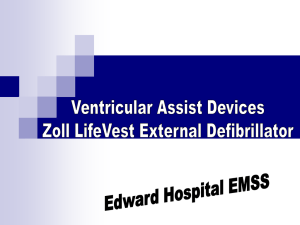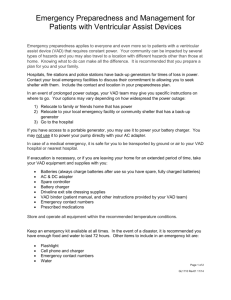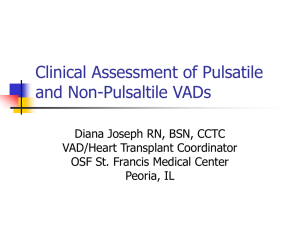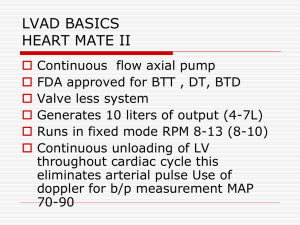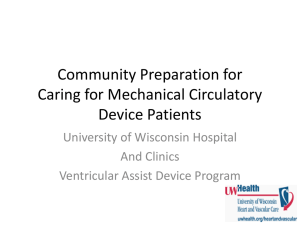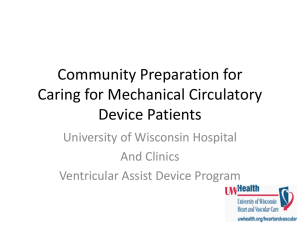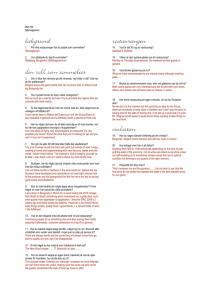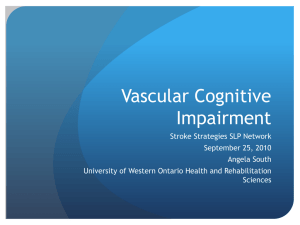An Overview of Ventricular Assist Devices
advertisement
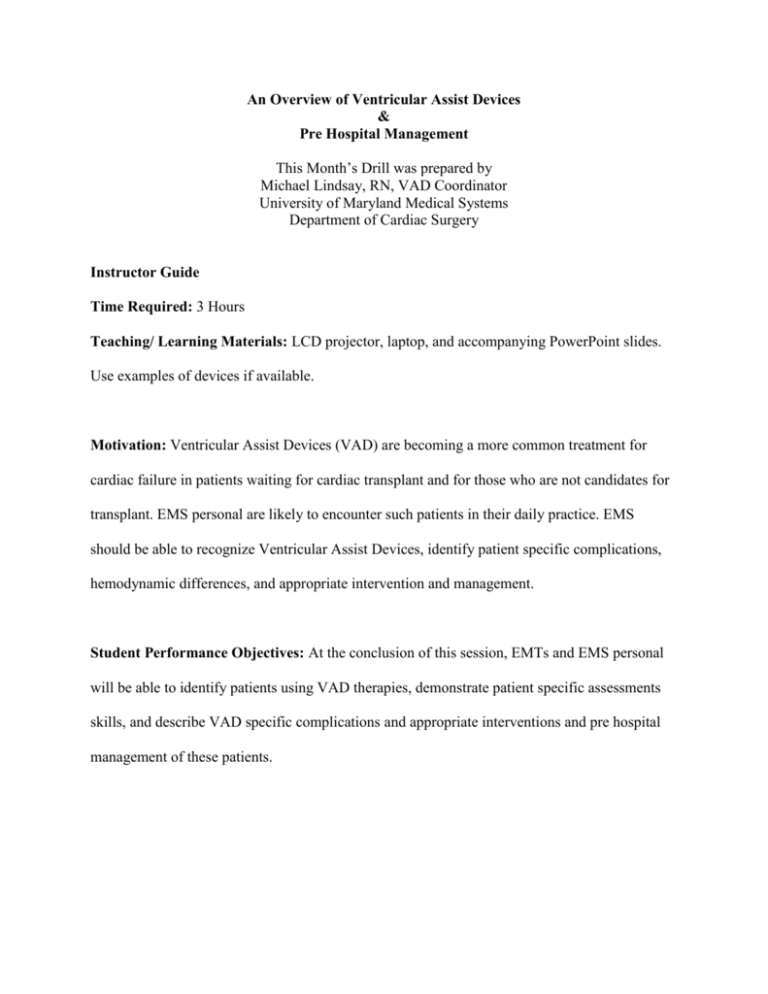
An Overview of Ventricular Assist Devices & Pre Hospital Management This Month’s Drill was prepared by Michael Lindsay, RN, VAD Coordinator University of Maryland Medical Systems Department of Cardiac Surgery Instructor Guide Time Required: 3 Hours Teaching/ Learning Materials: LCD projector, laptop, and accompanying PowerPoint slides. Use examples of devices if available. Motivation: Ventricular Assist Devices (VAD) are becoming a more common treatment for cardiac failure in patients waiting for cardiac transplant and for those who are not candidates for transplant. EMS personal are likely to encounter such patients in their daily practice. EMS should be able to recognize Ventricular Assist Devices, identify patient specific complications, hemodynamic differences, and appropriate intervention and management. Student Performance Objectives: At the conclusion of this session, EMTs and EMS personal will be able to identify patients using VAD therapies, demonstrate patient specific assessments skills, and describe VAD specific complications and appropriate interventions and pre hospital management of these patients. Enabling Objectives: Define Heart Failure and Ventricular Assist Device (VAD) Describe Indications of Using VAD Therapy Describe the differences between Pulsatile & Non-pulsatile VAD flow Describe common VAD complications Describe VAD patient specific assessments Describe treatment and patient field management Definitions Indications for Use Types of Devices Common VAD issues/ complications Patient assessment Pre Hospital/ Field management of VAD Patients Overview: I. Definitions A. Heart Failure 1. A condition where the heart cannot pump enough blood throughout the body 2. It develops over time as the pumping action of the heart grows weaker 3. Most cases involve the left side where the heart cannot pump enough oxygen-rich blood to the rest of the body. 4. With right sided failure, the heart cannot effectively pump blood to the lungs where the blood picks up oxygen. B. Ventricular Assist Device 1. A single system device that is surgically attached to the left ventricle and the aorta for left sided support. 2. For Right sided ventricular support, the device is attached to the right atrium and to the pulmonary artery II. Indications for Use A. Bridge to transplant B. Destination therapy C. Bridge to recovery D. Bridge to candidacy III. Pulsatile vs. Non-pulsatile A. Pulsatile 1. Ventricle-like sac devices 2. Blood enters via a flexible tube, fills up the pumping chamber, then is ejected into systemic circulation via the outflow cannula 3. Electric motor or pneumatic pressure collapses the chamber and forces blood into systemic circulation 4. Can be left ventricular support (L VAD), right ventricular support (R VAD), or bi ventricular support ( Bi VAD) 5. First generation devices 6. Patients will have a palpable pulse and a measurable blood pressure. Both are generated by the devices output. B. Non-pulsatile 1. Continuous flow devices. Impeller spins and constantly pulls blood from the ventricle and continuously pushes it forward into systemic circulation 2. Most implanted devices are L VAD only 3. Are quite and cannot be heard outside the patients body 4. The patient may have a weak, irregular, or non-palpable pulse. 5. The patient may have a narrow pulse pressure and may not be measurable with an automatic blood pressure cuff. 6. The mean arterial pressure (MAP) is the key to monitoring hemodynamics. Ideal range is 60- 90 mmHg IV. Common Device Issues/ Complications A. Bleeding B. Thrombosis C. Infection D. Right ventricle dysfunction E. Suckdown (non-pulsatile devices only) F. Device failure/ malfunction G. Hemolysis H. Arrhythmias I. Hyper/ hypotension J. Anxiety & Depression K. Portability/ ergonomics V. Patient Assessment A. Assess for signs of overt and covert bleeding 1. Hypotension 2. Neuro impairment 3. Epistaxix 4. GI Bleeding B. Thrombosis 1. Device making grinding sounds 2. Dark Urine 3. Hypotension 4. CVA ? C. Infection 1. Fever 2. Hypotension 3. Odorous drainage from driveline 4. History of infection D. Right Ventricular Dysfunction 1. Edema 2. Jaundice 3. Ascidies E. Suckdown- LV collapse due to hypovolemia or VAD overdrive 1. Hypotension 2. PVCs/ Vtach 3. Knocking sounds heard when auscultation of the device. F. Device failure/ Malfunction 1. Determine if the device is on 2. Listen for alarms 3. Assess for signs of hypoperfusion 4. Assess for hypotension G. Hemolysis 1. Dark Urine 2. Increasing VAD power 3. Hypotension 4. Irregular VAD sounds H. Arrhythmias 1. Treat the patient not the monitor 2. Determine the patient’s cardiac rhythm 3. Assess and determine if the patient is stable or unstable I. Hypertension/ Hypotension 1. Assess for signs of low perfusion 2. Assess BP manually and with a Doppler if available. 3. Mean Arterial Pressure is key in Non-pulsatile devices J. Depression/ Anxiety 1. Are they taking psych medications? 2. Any history of anxiety or depression? 3. Assess for signs of the patient trying to hurt themselves. K. Portability/ Ergonomics 1. Does the patient have all of the necessary VAD equipment for transport 2. Determine the closest VAD implanting medical center VI. Pre Hospital/ Field Management A. All VADs are dependant on adequate preload in order to maintain proper function B. Volume resuscitation in an unstable VAD patient is the first line therapy C. Do not administer nitrates unless instructed by physician or implanting center’s VAD coordinator. D. Initiate IV therapy on all VAD patients E. Assess and treat for other, non VAD related, injuries and complications F. Only cardiovert/ defib the patient if they are unstable. VAD patients may be in a lethal arrhythmia but remain stable. G. Airway and breathing per ACLS protocol. H. DO NOT INITIATE CPR unless instructed by physician or implanting center’s VAD coordinator. Internal hardware may become displaced and cause internal bleeding and possibly death. I. Identify your resources 1. Locate the number for the implanting center’s VAD Coordinator 2. Listen to family and friends. They likely have been trained on how to manage the device 3. Look in the patient’s equipment bag for manuals and quick guides J. Transport to the implanting center when able. Not all centers are equipped to manage these complex patients K. Allow the patient’s caregiver to remain with the patient L. Transport all VAD equipment with the patient M. All equipment and cords attached to the patient should be secured and tangle free for transport to prevent device damage. Summary: At the conclusion of this session, EMTs and EMS personal will be able to identify patients using VAD therapies, demonstrate patient specific assessments skills, and describe VAD specific complications and appropriate interventions and pre hospital management of these patients. EMTs and other EMS personal will follow acceptable Maryland medical practice and Maryland Medical Protocols for Emergency Medical Providers when indicated. Review: Ventricular Assist Devices (VAD) Define the following terms o Heart Failure o Ventricular Assist Devices Describe Indications of Using VAD Therapy Describe the differences between Pulsatile & Non-pulsatile VAD flow Describe common VAD complications Describe VAD patient specific assessments Describe treatment and patient field management
